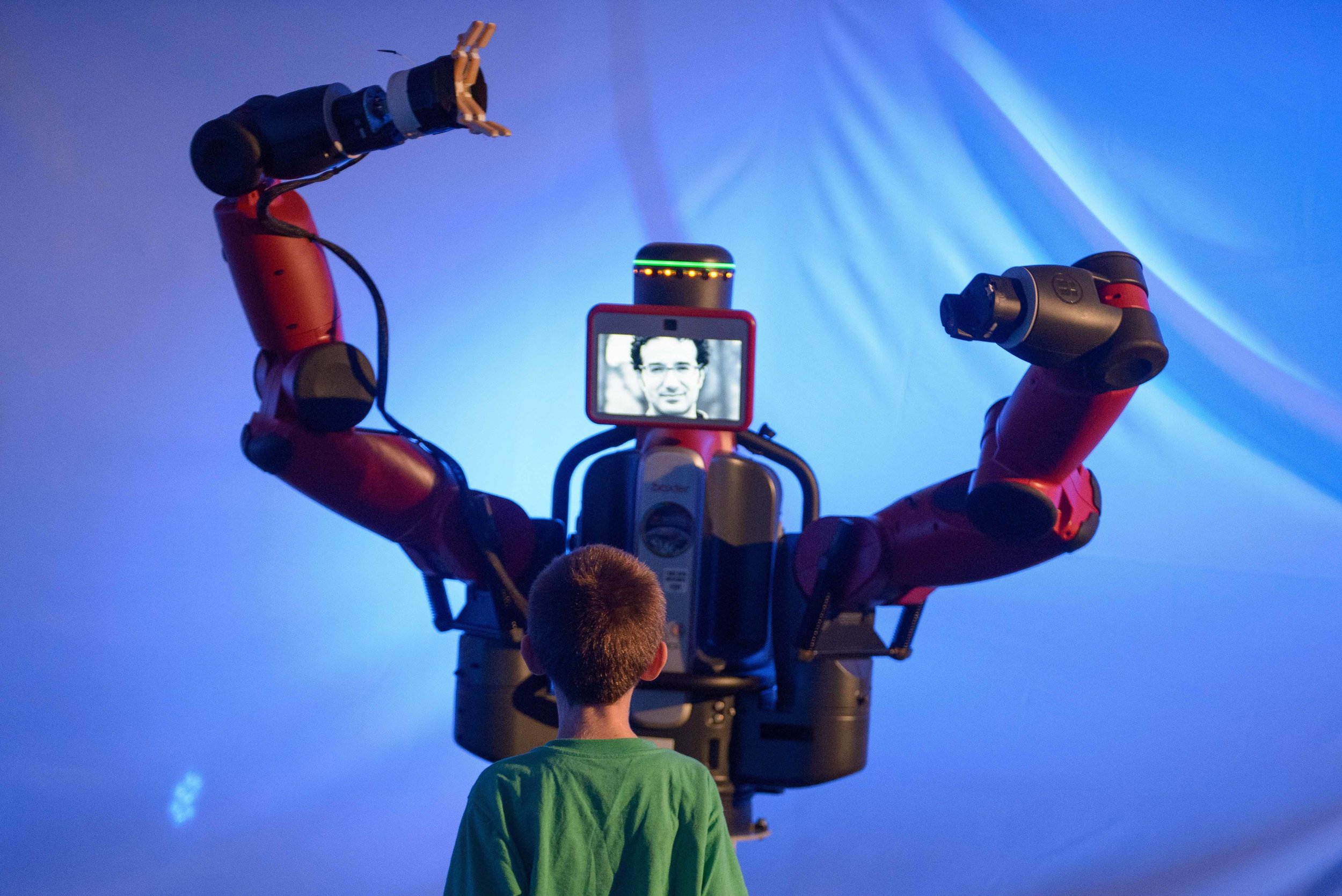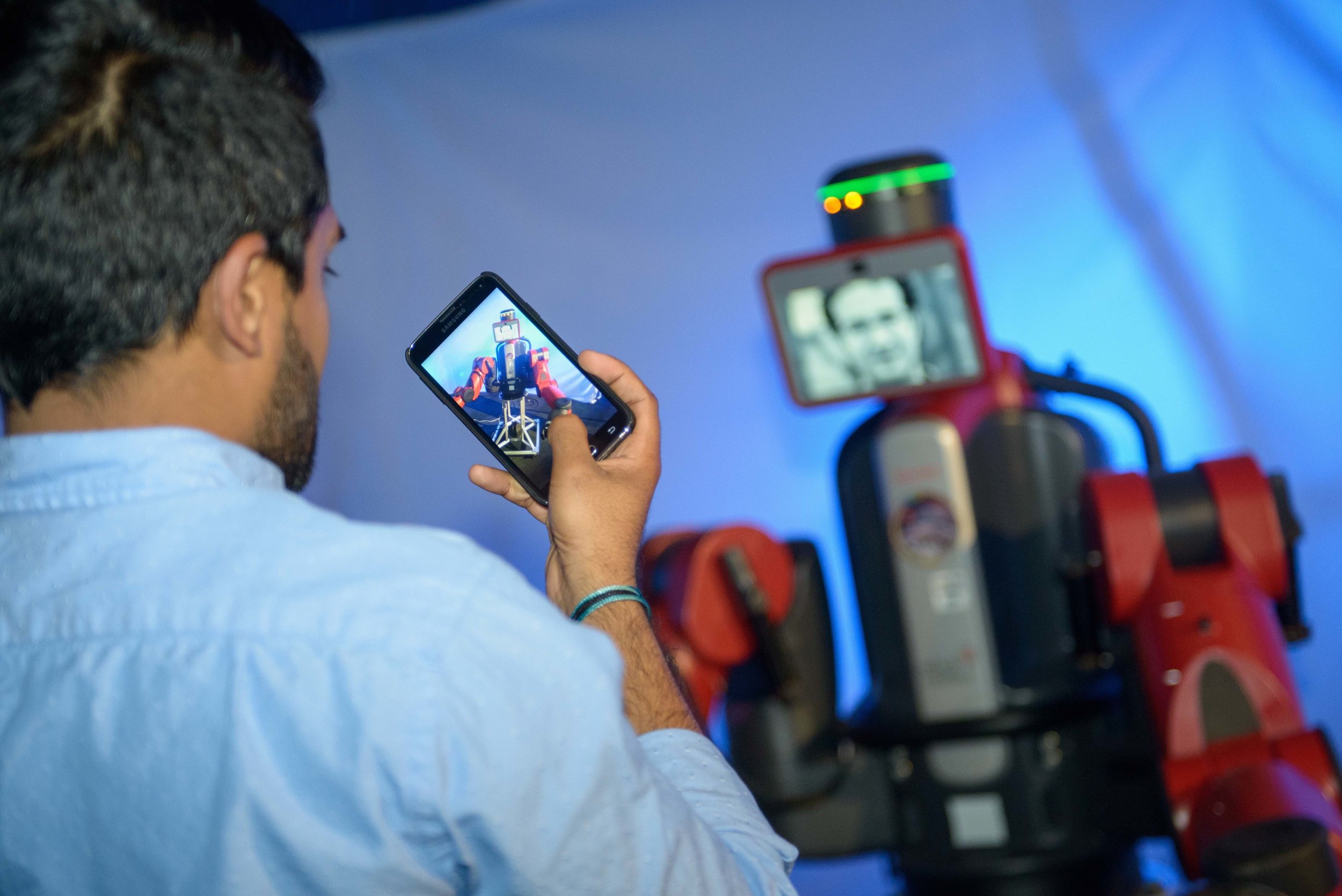Ars Robotica is a transdiciplinary initiative in robotics and the arts
Our Mission
advance research in robotics and artificial intelligence through the methods and insights of the arts
produce creative, thoughtful, and compelling public experiences
YOU n.0
a triptych
Two clowns, an aerialist, and a robot walk into a tent…
YOU n.0 is a series of performed metaphors about the past, present and future of human/robot relations, a circus meditation on the ages of the individual since modernity. It features Baxter, an industrial robot from Rethink Robotics, interacting with clowns, an aerialist, and a behind-the-scenes team of designers, programmers, and technicians.
Lead artist: Lance Gharavi
Lead roboticist: Sai Vemprala
Sound & Systems designer: Steve Christensen
Costume designer: Kelsey Christian Maryanne Kelly
Production Manager: Kara Chesser
Performers: Lauren Breunig, Brian Foley, Chelsea Pace, Baxter (a robot)
The Mirror
How can we teach a robot to perform? To dance?
Young performers start to learn their craft through imitation. Beginning dancers learn by imitating more experienced dancers. A common exercise in early actor training is “The Mirror,” where one performer precisely copies the movements of another.
This is where we began with Baxter.
Our aim is to produce autonomous, fluid, expressive behavior.
Progress of research
Selected as a Transdisciplinary “Exemplar” Project by The Alliance for the Arts in Research Universities (a2ru)
Lead Artist: Lance Gharavi
Roboticists: Srikanth Saripalli, Sai Vempralla
Systems Design: Matthew Ragan, Ian Shelansky
Sound Design: Steve Christiansen
Movement Analysis: Becky Dyer
Dancer: Molly Schenck
Robotopolis
designing the city of the future
To build the future, we start small.
A collaboration with the Center for Human, Artificial Intelligence, and Robot Teaming (CHART), Robotopolis is a testbed for interacting teams of autonomous and remotely piloted vehicles. It is a laboratory designed to investigate the risks that arise when driverless cars and human-operated vehicles share the roads, to test systems that mitigate those risks, and to do so in a safe, controlled environment.
It is also an art installation, a performance space where the performers are robots and humans.
Robotopolis features two cities occupying the same location: one you can see, and another you can’t. The invisible city only makes its presence know by the shadows it casts. Projectors cast these shadows over the environment in an extended animation that represents a full day in the life of the two cities.
Robotopolis is simultaneously a site for conducting science, and also for contemplating its human impacts and costs. The work engages the ways in which the emergence of automation, global capitalism, and white supremacy intersected in history, structure our present realities, and shape our visions off the future. It is a meditation on those things that get erased and made invisible, things that get forgotten or ignored, things that are left out of our fables of yesterday and dreams of tomorrow.
Robotopolis was supported by a grant from ASU’s Herberger Institute for Design and the Arts.
Lead artist: Lance Gharavi
Lead scientists: Spring Berman, Lixiao Huang
Engineering team: Mustafa Demir, Shenbagaraj Kannapiran
Architecture design: Dallas Nichols
Sound design: Stephen Christensen
Media design: Max Bernstein
Production: Kyle Blomquist, Zachary Bursi
GHOST Lab
an archeology of the future
A collaboration between Ars Robotica and the Center for Human, Artificial Intelligence, and Robot Teaming (CHART), GHOST Lab is a laboratory for experiments with diverse groups of robots, artificial intelligence (AI), a networked unmanned aerial vehicle (UAV) lab, and human teaming.
GHOST Lab is also an art installation and performance space where the performers are robots, AI, and humans. It is a space for conducting research and also for reflection and meditation on the research itself.
The work features interactive sound and lighting that supports diverse experimental purposes. The space is highly flexible and reconfigurable to enable a broad variety of experimental scenarios.
Concept Statement
This is a fraught space. A haunted space.
It is haunted by countless stories, spoken and unspoken, written and erased, dimly remembered and purposely forgotten. It is haunted by histories of violence, by present contests, and by fantasies and nightmares of the future. These are stories of abjection, alienation, enslavement, and labor under capitalism. These are stories of hope of redemption and fear of annihilation. Like all stories, they are mirrors; sites for reflection.
All robotics labs are haunted in this sense. We just designed a lab with the ghosts in mind.
Lead artist: Lance Gharavi
Lead scientist: Nancy Cooke
Science and Engineering team: Lixiao Huang, Spring Berman, Erin Chiou, You Zhang, Ravi Pipaliya, Subbarao Kambhampati, Mustafa Demir, Jessica Dirks, Bethany Lang, Stephen Cauffman, Mark McMillan
Scenic design: Brunella Provvidente
Sound design: Max Bernstein
Lighting design: William Kirkham
Project Manager: Pauline Jewett
Technical Director: Jack Pieza
Master Electrician: Zane Pettiford
GHOST Lab is a work-in-progress. Scheduled for completion in summer 2021.
GHOST Lab was supported by a grant from the Office of Naval Research.







































